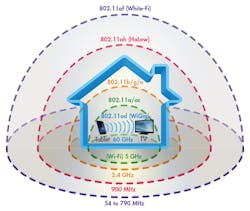This file type includes high-resolution graphics and schematics when applicable.
Wi-Fi is by far one of the most widely used forms of wireless technology. We use it for email and internet access, and multiple other applications. Our laptops, tablets, some TV sets, and smartphones connect by way of a home router, access points at work, and public hotspots in hotels, airports, and coffee shops. Continuous new development keeps the technology up to date and relevant. Imagine not having Wi-Fi.
As Wi-Fi standards have developed, every generation has effectively been a straightforward replacement of its predecessor. The latest version, 802.11ac, for example, is faster, less prone to interference, and offers better range than 802.11n, g, b, and a. Crucially, Wi-Fi has also been backwards-compatible, meaning users needn’t replace every wireless device in their home when they get a new router or phone.
Currently, the most significant Wi-Fi activity is the roll out of its most recent version (IEEE standard 802.11ac). According to a report from ABI Research, shipments of Wi-Fi access points using the 802.11ac standard are gaining momentum, and accounted for 39% of all those shipped in the last 12 months. And with 802.11ac Wave 2 products and tri-band access points coming to market during 2016, this trend is expected to accelerate.
Indeed, Wave 2 access points are forecast to account for almost two-thirds of all Wi-Fi access-point shipments in 2016, according to ABI Research Managing Director and Vice President Sam Rosen.
But as the world of connected devices develops, so must Wi-Fi. To that end, the “one-size-fits-all” model we’ve seen to date is changing. What we’re seeing develop now are essentially three, or possibly four, versions of Wi-Fi, each for a specific purpose. Figure 1 shows some of the different versions of Wi-Fi, the different frequency assignments, and relative range of communications. Let’s look at the specifications and role of each one.
1. The standard data channels used by millions for internet access are being complemented by the high-speed WiGig standard (802.11ad), as well as the long-distance HaLow (802.11ah) and White-Fi (802.11af) standards.
802.11ac Wi-Fi
As touched on above, 802.11ac is the latest version of the Wi-Fi Alliance’s general network standards. In theory, it enables maximum speeds of 1.3 Gb/s, though independent real-world tests show typical speeds of between 250 and 300 Mb/s on smartphone-style single-input, single-output (SISO) antenna configurations. These real-world speeds are around two-and-a-half times faster than what could be achieved with 802.11n, where the 450-Mb/s theoretical maximum translated to real-world speeds between 50 and 150 Mb/s.
Of course, speed is only part of the story: Range and propensity to interference are the key make-or-break factors for wireless technology. From 802.11b onward, Wi-Fi has used the ISM 2.4-GHz band, which is license-free. This is shared with common technologies such as Bluetooth, ZigBee, and even microwave ovens. However, 802.11n made the jump to the 5-GHz band, which is faster, quieter, and less prone to interference. The 802.11ac standard completes this move.
While 2.4-GHz broadcasts will transmit further in lab tests than those at 5 GHz, the amount of interference on the 2.4-GHz band means this range rarely translates into the real world. This is particularly the case when you add beamforming—a key part of the 802.11ac specification—to the mix.
The advent of 802.11ac Wave 2 will enhance the standard further, promising to improve speeds when several people are connected at the same time. It will also bring in space-division multiple access (SDMA), otherwise known as multi-user multiple-input, multiple-output (MU-MIMO).
While 802.11ac gains in popularity, the Wi-Fi Alliance and Huawei are already developing its successor: 802.11ax. Also using the 5-GHz band, 802.11ax is expected to add orthogonal frequency-division multiple access (OFDMA), be more flexible in its spectrum use, implement networks that self-optimize, and possibly even include low-power wakeup radio for Internet of Things (IoT) uses.
802.11ad (WiGig)
WiGig—802.11ad—became part of the Wi-Fi Alliance in 2013, when it merged with the Wireless Gigabit Alliance. WiGig was the first of the new specific-use Wi-Fi standards, created to facilitate very-high-speed data transfer using the 60-GHz band, which, like the 2.4-GHz band, is license-free. However, most recently, the FCC in the U.S. announced new rules for high-frequency wireless broadband operations, with a new unlicensed band available at 64-71 GHz. That will extend the 60-GHz band utilized by WiGig. WiGig is intended for uses such as streaming video from a server or mobile device to a television, or for mobile backhaul purposes.
The exact spec for this frequency band differs between countries, affording between 5 and 9 GHz of bandwidth. In Canada, the U.S., and Korea, it’s from 57-64 GHz. In Japan, it’s from 59-66 GHz, China is between 59 and 64 GHz, and the EU ranges from 57-66 GHz. Most recently, the FCC in the U.S. announced new rules for high-frequency (over 24 GHz) wireless broadband operations, with a new unlicensed band available at 64-71 GHz.
WiGig offers extremely high transmission speeds: Strategy Analytics estimates that a 4K ultra-high-definition (UHD) video at 60 GB will transfer in 2.3 minutes, while a 5-GB high-definition (HD) film will take just over 12 seconds.
WiGig works over relatively short ranges, typically line-of-sight between two and 10 meters, when used indoors. Its ability to pass through walls is limited. But for purposes such as streaming HD/UHD video from a mobile device to a television, from a movie rental booth to a mobile device, or to enable high-speed sync or data transfer between two devices, the limited range isn’t an issue.
However, there’s a major obstacle when it comes to implementing WiGig—namely, its high-speed complex digital sample rate, which is greater than 2.64 GHz. This leads to a real-time processing load of over 2 TOPS (teraoperations/s) if one is to deliver the level of signal processing required for 8-Gb/s data-transfer rates. This load is significantly greater than current wireless standards.
The sample-rate challenge, as well as the fact that many wireless semiconductor vendors have prioritized 802.11ac development, means that only a few firms are in a position to develop WiGig. These include the big three of Intel, Qualcomm, and Broadcom, along with specialist 802.11ad developers such as Blu Wireless. Blu Wireless Technology is a silicon IP company specializing in the design of configurable, flexible baseband technology for WiGig and other mm-wave applications.
We’re now seeing the first 802.11ad WiGig Wi-Fi chips appear on the market, and they’re expected to start materializing in high-end smartphones and tablets by the end of the year. Analysts at Strategy Analytics predict that around 10% of mobiles, portable computers, and media players will feature WiGig by late 2020.
The analysts go on to suggest that if Intel continues to push WiGig as a solution for computer docking purposes, we could see it shipping tens of millions of units every year, across a significant share of PC peripherals. WiGig is also showing up in short range mesh data networks (Fig. 2).
2. Blu Wireless Lightning modules have been installed as part of an experimental network in Bristol, U.K., the first mesh network trial in Europe to use 60-GHz and OpenFlow software-defined networking.
Finally, the report notes that a major factor on the WiGig market will be “the timing of Apple’s adoption of 802.11ad in iPhones.”
IEEE 802.11ay is the next-generation wireless standard at 60 GHz, and is expected to be completed in 2019. This new standard is an improvement over IEEE 802.11ad, combining the use of MIMO antenna processing with channel bonding to increase data rates to over 20 Gb/s, and extend transmission distance from the current 10 meters to as far as 300-500 meters. The new standard promotes focus on, and will enable, new applications for mobile offloading, wireless backhaul, and new types of products based on augmented-reality (AR) and virtual-reality (VR) technologies.
802.11ah (HaLow)
In the same way that WiGig has been developed to solve a specific and growing need, so has the Wi-Fi HaLow (802.11ah) standard. Where WiGig is all about transferring large amounts of data over short distances, HaLow is driven by the industrial Internet of Things’ need for remote machine-to-machine (M2M) communication. Exploiting the 900-MHz band, it uses very low power to transmit small amounts of data over long distances. These characteristics are essential, as HaLow’s applications will typically be in isolated systems whose only power source is a battery that must last 10 or more years.
As with WiGig, the allocated spectrum for HaLow varies between countries. China provides 32 MHz (755-787 MHz) and the U.S. 26 MHz (902-928 MHz), while in Europe it’s 5 MHz (863-868 MHz).
The IEEE 802.11ah standard is being finalized and should be available soon. That said, HaLow isn’t the only option in this space: LTE-M is already proving popular, similarly offering low-power, long-range communication, but based on the well-established 3GPP standard.
Given this competition, some analysts are warning that HaLow could arrive too late to make a significant impact, even though the first 802.11ah chipsets are expected this year. ABI suggests that at its launch, HaLow will lag behind its competitors and cost more. By 2020, it predicts, just 11 million devices per year will include 802.11ah chipsets.
802.11af (White-Fi)
The final variant in our Wi-Fi ecosystem roundup is 802.11af, or White-Fi. It’s a new standard and so far, no chipsets have been announced. White-Fi’s aim is to transmit large amounts of data over very long distances, taking advantage of unused white space in the television spectrum frequencies.
White-Fi uses spectrum known as white spaces. White spaces are unused TV channels (6 or 8 MHz). As with other versions of Wi-Fi, frequencies differ per country, from 54-790 MHz. White-Fi is expected to offer a range of several miles—superior even to HaLow—while being less likely to suffer interference.
That said, White-Fi has its limitations, not least of which being that while such white-space channels are ideal for use in remote areas, they cannot be used everywhere, including in large cities. White-Fi uses cognitive radio technology to avoid interference with TV and wireless microphone transmissions.
LTE-U/LAA
LTE-U (LTE-Unlicensed)/LTE-LAA (LTE-License Assisted Access) technology has been proposed to provide additional radio spectrum in the unlicensed 5-GHz ISM band to enable cell networks to offload data and boost speeds over short distances. The technology employs a control channel using LTE. However, all data flows over the unlicensed 5-GHz band, using a contention protocol known as listen-before-talk (LBT) in order to coexist with other Wi-Fi devices on the same band.
The proposed use of LTE-U is the subject of controversy, though, with many (including the Wi-Fi Alliance) concerned about the coexistence of LTE and Wi-Fi in the 5-GHz band, and the potential degradation in the Wi-Fi user experience. The Wi-Fi Alliance is currently working on a coexistence test plan that will be acceptable to the mobile operators. In FCC filings, Qualcomm, Verizon, and T-Mobile have committed to use an agreed-to test plan from the Wi-Fi Alliance with the hope of a full implementation before the end of 2016.




